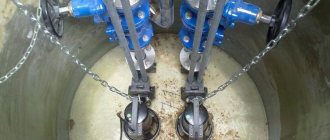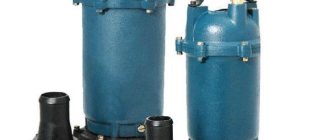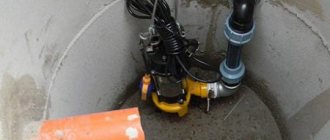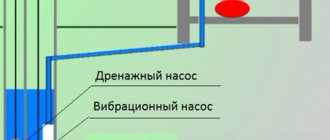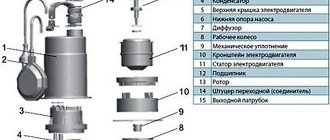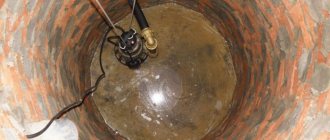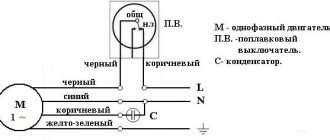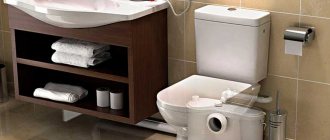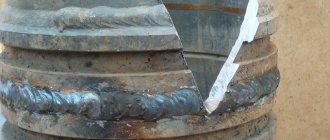What is a septic tank pump and features of choice
The pump is designed to clean a septic tank from wastewater and fecal matter. Its operating principle is similar to that of a conventional pump, but has a number of features. They are associated with the need to function in an aggressive environment and the ability to cope with fairly large debris.
There are several parameters according to which the optimal type of equipment is selected.
- Operating duration, switching frequency. If the pump is needed for a summer residence, but will be used occasionally, you can choose a simpler and cheaper pump model. When choosing equipment for a private home with permanent residence, you should pay attention to more powerful and reliable models.
- Tank volume. There is no need to give preference to a compressor with very high power if the septic tank is of modest size. A weak compressor will be ineffective when it is necessary to drain water from a large septic tank.
- Sewer depth. Compressors do not have universal power, so different models can lift water from different depths. To make the right choice, you should know the vertical length of the well and take into account the length of the hose connecting the septic tank to the place of transportation.
The pump power is selected depending on the depth of the well Source bg.decorexpro.com
- Consistency of the pumped liquid (exclusively water with minimal inclusion of sand or the presence of large solid fractions).
- The aggressiveness of the environment in which the equipment will operate. Not all models are equipped with a reliable housing that is resistant to aggressive environments. An incorrect choice can lead to early failure of the unit.
To provide guidance in the range of pumping equipment, manufacturers use different markings. For example:
- “F” indicates that the compressor is designed for septic tanks with dirty water and is capable of removing solid fractions up to 3.5 cm in size.
- "H" means the pump body is made of stainless steel. Therefore, it can be used in aggressive sewage environments.
- Numerical designations indicate that the pump can pump out exclusively water with a minimal admixture of fine sand.
Pressure sewer connection diagrams
The pressure sewer can be filled completely or partially. In the first case, the wastewater is fed into a storage tank, and in the second, it rises to the required height to create an optimal slope for gravity drainage. The wastewater can flow to the pump by gravity.
Scheme of a classic intra-house sewer system
Let's consider a standard sewer pump connection diagram (shown in the photo above):
- 4 plumbing fixtures are installed on the ground floor of the house: shower, toilet, sink and bidet;
- these devices are connected to a pumping station - a complex mechanism;
- plumbing fixtures are connected to the inlet pipes of the station, and the drains move by gravity along this path;
- when water flow begins, the device starts in automatic mode and begins to lift the wastewater up the pressure pipe.
The maximum lifting height is 8-10 meters. Theoretically, it can be greater if we use only numbers, but not only the maximum pressure drop is taken into account, but also losses.
Operating principle of the pumping station
To understand how it works, consider the internal component of the pumping station.
Construction of a sewage pumping station
There are 5 pipes coming out of the plastic casing - one large for connecting the toilet, three small for connecting to various plumbing fixtures, and 1 outlet, pressure, through which the drains rise to the top.
Attention! Unused pipes are plugged.
There are different mechanisms inside. The main one is an electric motor, which drives the pump and the cutting mechanism, which crushes the solid parts of the wastewater.
The shredder is a must, since the outlet pipe is connected to the 50th pipe, which can easily become clogged.
Types of pumps
To remove dirty water, there are drainage and sewage pumps.
Drainage
A drainage pump for a septic tank is used to drain water with a minimum amount of solids. It will cope with particles of sand or silt. To prevent the equipment from malfunctioning due to mechanical failure, it is protected by a mesh that does not allow large debris to get inside the mechanism.
There is a protective mesh on the drainage pumps at the bottom of the housing. Source vse-o-kanalizacii.ru
The drainage pump will not be able to pump out sediment from the bottom of the septic tank. It also cannot cope with the removal of fecal matter. It is designed to pump water from a storage well, which receives purified water from a septic tank, storm and drainage sewer.
Fecal
Equipment of this type is intended for cleaning septic tanks and cesspools. They do an excellent job of removing water and solids. The size of solid parts that the pump can handle depends on the model, but does not exceed 5 cm. To clean the septic tank from larger debris, the pump is often equipped with a shredder. It is a shaft with cutting blades.
Sewage pump for a septic tank with a grinding mechanism Source ovk.ua
See also: Catalog of companies that specialize in water supply and sewerage.
Fecal pump and its design
Its difference is the ability to pump liquids including solid fractions.
This device is extremely widely used, and primarily it is used for pumping cesspools and septic tanks. This device is also very helpful for those homeowners whose areas are periodically flooded with melt water or during river floods. With their help, water is quickly removed from the basement.
There are situations that even if you have a central sewer system, you have to install such a unit. For example, with a long gravity pipeline, when the slope of the pipe must be maintained, but for some reason this was not possible. For the normal functioning of the entire system, in this case it is necessary to use a pump to pump out the incoming fecal matter.
According to the method of installation and design, devices are divided into the following types:
- Submersible;
- Semi-submersible;
- Located on the surface.
Each type of equipment has its own advantages and disadvantages. Let's look at what they consist of and what differences there are in functioning.
Septic tank pumps by type of application
Sewage pumps are divided into submersible, surface and semi-submersible.
Submersible
Submersible pumps for septic tanks are equipped with a sealed housing. The material is stainless steel or cast iron. The working mechanism is completely protected from the negative influence of waste liquids.
For proper operation and long service life, equipment must be completely immersed in liquid. Therefore, it is installed at the bottom of the sewer well.
There are 2 ways to install pumping equipment:
- Stationary.
- Mobile.
Regardless of the chosen installation principle, it is necessary to provide for the possibility of lifting the compressor for maintenance and repair.
The bottom of the submersible pump housing is equipped with special holes. Through them, liquid and fecal matter are absorbed. They are raised to great heights by the power of the pump, which creates the required pressure in the system. To protect the motor, a special filter is installed that prevents too large debris from getting inside.
Submersible sewage pump for septic tank Source bg.decorexpro.com
Advantages:
- Reliability.
- Compactness.
- Efficiency.
- Silence.
Flaws:
- Difficult to install.
- The need to lift the pump to service it.
How can it be installed?
Based on the installation method, three types of equipment can be distinguished:
- superficial;
- semi-submersible;
- submersible
Superficial
This equipment option has a low price. A feature of the equipment is that it must be mounted at a distance from the liquid tank. Such equipment has a low level of waterproofing, so if moisture gets into the engine compartment, the unit may fail.
External pumps are rarely installed permanently; as a rule, they are used periodically, for example, when basements are flooded. Surface pumps for septic tanks are rarely used; they have insufficient performance and a high risk of breakdowns.
Submersible
This option equipment is installed directly in the pumped medium. Therefore, it has a waterproof body, which is made of corrosion-resistant materials. The unit is installed inside the tank, and so that the equipment can be removed at any time, it is attached to a steel chain or cable.
Special guides are installed in the tank itself to hold the body of the unit, and the suction pipe should be located at the bottom of the tank. Submersible pumping equipment is quite powerful, so it is not advisable to use it in dachas and other facilities with a small amount of wastewater.
Semi-submersible
This equipment is equipped with a special float, so the compartment with the motor is located above the liquid level, and the suction pipe is located at the bottom of the container.
Popular pump brands and their costs
Grundfos
The Danish manufacturer of pumping equipment is one of the market leaders. The company does not rest on its laurels and is constantly working to improve its pumps. Their products are distinguished by the high quality of the materials used and workmanship. Such pumps are chosen by those who value quality, efficiency and advanced technology. A large assortment of pumps allows you to choose the right equipment based on your individual needs.
The equipment belongs to the expensive segment. Depending on the model, the cost of a pump for a septic tank varies from 15 to 60 thousand rubles.
Which pump to pump out sewerage in a private house
The listed types of pumps are installed on storage tanks. This is a feature of the equipment that requires that no air gets inside the system, which could cause the pump to overheat and reduce its performance.
This is especially true for surface pumps. That is, the suction hose must be immersed in water.
In-house compact pumping stations are designed exactly according to the same principle, only a small building plays the role of a container. Pumps can be installed both inside such systems and outside, as can be seen from the photo below.
Pumping station with surface power unit
A home sewage pump is a direct analogue of the pump that is installed inside a washing machine. It is easy to use and allows you to install plumbing fixtures in any location without any problems.
Products from well-known brands, such as Grundfos or Ebara, are famous for their high reliability.
Maintenance of such pumping stations is simple - it is necessary to wash the internal storage tank at some intervals and periodically change the carbon filter, which can be installed inside to “kill” unpleasant odors.
Video description
For an example of how a Grundfos pump works with a grinding device, see the video:
Pedrollo
Pumping equipment from an Italian manufacturer is in high demand. It is characterized by high reliability and the ability to choose a compressor for any need. The line of sewerage equipment includes several hundred items. The disadvantage of this manufacturer’s equipment is that there are fakes on the market. Therefore, you should carefully consider where you purchase the pump.
The cost depends on the model and ranges from 16–100 thousand rubles.
Gilex
The Russian manufacturer produces compressors for septic tanks that work reliably in almost any difficult conditions. The models do not have a large number of functions and do not contain many innovative solutions. They are simple and unpretentious. Due to this, they work for a long time. In case of breakdown, they are easily and quickly repaired.
The price depends on the model and ranges from 3–6 thousand rubles.
Vortex
Russian company producing equipment in China. Despite this, their pumps are in demand and receive good reviews from owners. They don't have any superpowers. But buyers are attracted by their low price (compared to world leaders), quality of materials and reliability.
The cost ranges from 6 to 11 thousand rubles.
Pumping options
In principle, there are only three ways to pump out a sewer in a private house. The first - it is the simplest and most unpleasant - is to pick up a bucket yourself, with a rope tied to the handle, and scoop up the accumulated dirt in this old-fashioned way. More recently, this is what summer residents did, whose sewage system was in the form of a cesspool.
Manual pumping method
By the way, there are two types of drainage pits, which differ from each other in the tightness of the structure. That is, one of the options is a sealed well, the second in its design does not have a bottom. That is, the wastewater comes into contact with the soil, through which the liquid components penetrate into the bowels of the earth, or more precisely, into the groundwater. They pass through a thick layer of natural filter in the form of sand and rocky soil, leaving impurities on it, and clean water enters the groundwater layer. So, the frequency of cleaning a sealed well is frequent compared to a leaky tank.
The second pumping method is to use a sewage disposal machine. It has also been known for a long time, but summer residents rarely use it. It's all about the high cost of the service. Although this type of sewer pumping is considered the most effective and fastest. A sewage disposal machine can pump out a fairly large volume of sewage, while its vacuum pump is powerful enough to suck even large non-rotten particles (organic and inorganic) into the tank.
Sewage disposal machine
It should be added that all modern sewage disposal vehicles are equipped with long hoses (up to 50 m). And if quite recently it was necessary to organize an access to a cesspool or septic tank, or to arrange them near the fence of a dacha plot closer to the road, then today this is not necessary. The length of the hose is enough to pump out sewage from a well located in the depths of the summer cottage.
As for the high cost of the proposed service, summer residents today solve this issue with minimal losses. To do this, several houses are united for one call, thereby spreading the payment for the service across everyone. At the same time, the integrity of the contractor must also be taken into account. There are often cases when sewage pumped out of a well or septic tank was dumped into the nearest copse.
And the last third option for pumping out sewer pits is to use pumps. Of all the technologies used, this one can be considered effective and inexpensive. Of course, at the first stage you will need to purchase this very pump.
Pump installation
Fecal scraper with cutting mechanism
To pump out viscous masses with solid inclusions, the installation must have a grinder. There are several variations of them that are found in different installations.
- Impeller with knives. The cutting element is fixed to the screw itself. Some may have a cast iron chopper.
- Cylindrical scissors-knives.
- Cross cleaver.
- Cutter. The operating principle is reminiscent of a household kitchen meat grinder.
- Lamellar cutters.
Each of these shredders has its own operating principle. But efficiency largely depends on the grade of steel used.
Therefore, when choosing a unit, pay attention to the cutting mechanism.
